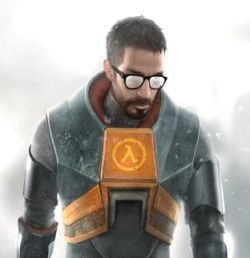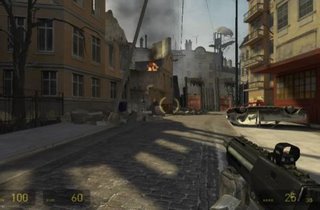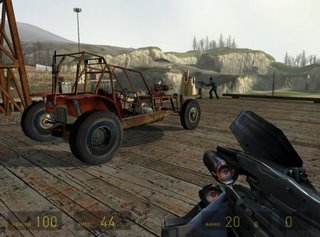Valve, Half-Life and the future of open-ended gameplay
I've just read a two-part interview -- part 1 and part 2 -- with Valve (creators of Half-Life) on Eurogamer and I'm feeling a little disheartened about the future of one of the most famous PC game franchises.
First, a quick history lesson for the uninitiated: In 1998, Valve released Half-Life, a first-person shooter for the PC. In the game you play the role of a scientist/action hero, Gordon Freeman, who manages to open a portal to another dimension on his first day working at a top-secret government research facility.

It's not much of a stretch to say that Half-Life pretty much single-handedly revolutionised the FPS genre, despite an admittedly lacklustre final act. It managed this in several ways. First, there are no cutscenes: everything in the game is seen from the player's point-of-view. This means you're never taken out of the action; not even for a second. From the introductory train ride through the Black Mesa research facility to the final confrontation on Xen, you effectively become Gordon Freeman. Then there's the astonishing use of in-game set-pieces. Half-Life managed to incorporate the kind of jaw-dropping action sequences previously seen only in cutscenes into the actual game itself. There are just so many memorable moments--anyone who's played Half-Life will remember the scientist falling down the lift shaft; the first encounter with a head crab; cautiously creeping past the blind multi-tentacled alien in the blast pit; or desperately dashing for cover to avoid the black helicopter on the surface. Finally, and perhaps most significantly, there's the variety and pacing of the gameplay itself. You never spend too long on a single task in Half-Life; one minute you're tangling with soldiers, the next you're trying to figure out how to cross a room filled with electrified water... Despite being utterly linear, Half-Life succeeds because it constantly changes the challenge for the player.
In 2004 -- six years later -- Valve released the hugely awaited follow-up, Half-Life 2. The anticipation surrounding the release was such that, in one gaming magazine, a simple picture of a crowbar (Freeman's signature weapon) on a white background was enough to send fans into a frenzy of speculation about the sequel. Perhaps inevitably for a game with so much media attention, first impressions of Half-Life 2 were mixed. Some fans were unreasonably disappointed that it wasn't the game they'd already designed in their head. That's not to say it wasn't well-received; the game enjoyed almost universally high scores from most of the big-name PC game sites. However, this time round the watchword was evolution, rather than revolution. Half-Life 2 didn't reinvent the wheel, it just fitted brand new treads and pimped it out with a set of shiny, chrome 20" rims.

With HL2, Valve once again showed they were masters of pacing and variety in FPS gameplay. What's more, the gravity gun introduced an entirely new (and incredibly fun) way for the player to dispatch the bad guys. It's a simple idea: pick up objects with the right mouse button, blast them away from you with the left. Of course, it helps if the object in question is heavy or sharp, or, preferably, both.
At first, I was one of those fans who was a little disappointed with the game. It didn't stand out from the competition in the way the original game had; at least, not obviously so. On the first run through, it felt like just another "on rails" shooter, albeit an exceptionally well-produced and entertaining one. On subsequent plays, though, I've come to appreciate the thing that, for me, sets Half-Life 2 above the rest. I've fallen in love with the atmosphere of the game.
I suppose I should explain that I'm a bit of a sucker for post-apocalyptic settings in general -- think 28 Days Later, Day of the Triffids, or Fallout; but not Reign of Fire or The Day After Tomorrow (I have standards!). There's something intriguingly chilling and exhilirating about seeing the highest works of mankind laid to waste by forces more powerful than we can comprehend. I also find it strangley compelling to speculate on the way in which humans, faced with such a scenario, would rise from the ashes and start again. Half-Life 2 is a veritable feast of post-apoc goodness. From the decaying Eastern-European vibe of the Orwellian City 17 to the zombie and antlion-infested coastline, the game leaves you feeling uneasy and with the strong impression that something VERY BAD™ has happened in the not-too-distant past. What's more, HL2 never spoon-feeds the player the backstory; you're left to glean what information you can from discarded newspaper clippings and fragmentary public service announcements. For me, this approach is a winner.
One of my favourite moments in the game comes when you finally escape from City 17 and make it out onto the Highway in a souped-up dune buggy.

There is something incredibly eerie about driving along the coastline, past deserted houses and shacks which are now home only to families of zombies and headcrabs. The other reason why this section of HL2 made such a strong impact on me was, I think, because of the change of pace. HL2 is not a freeform game by any means, but this part did allow you to head off the beaten track and explore a bit. It's moments like this, in my view, that showcase HL2 at its best and which make it a progression from the original Half-Life.
Fast-forward to 2006 (I've always wanted to use that line). Valve just released Half-Life 2: Episode 1. Is it an expansion pack or is it a sequel? Hard to tell, really. In the Eurogamer interview, Valve claims it's more of a sequel since it deals with events which take place directly after HL2, but it's certainly around the length of a conventional expansion pack (5 hours or so). But maybe that's because Valve have, with this game, decided to commit to releasing so-called 'episodic content' instead of full-fledged releases every 5 or 6 years. It's a brave decision, and I'm not fully convinced one way or the other at this point. Probably this'll be the subject for another post...
The point of all this rambling nonsense is this: HL2:E1, while maintaining the astonishing post-apocalyptic atmosphere of HL2, is actually even more linear than its predecessor. It's not that it's a bad game. It's certainly classically Valve in that it never lets up the pace and is consistently entertaining. However, after completing it I was left with the overwhelming sensation that I was being simply shepherded from one encounter to another with little chance to stop and catch my breath. "Well, that's just Half-Life," you'd say. Well, yes, but both the original game and HL2 managed to hide the linearity pretty effectively, whereas Ep1 is less successful in this regard. More importantly, there's something that Gabe Newell (head of Valve software) says in the Eurogamer interview which is most revealing about Valve's underlying philosophy of game design. When discussing Warren Spector's controlled, yet open-ended approach to game design, Gabe says:
Robin Walker, another Valve designer, adds that he wants to make sure all players have the same experiences while playing the game. But surely this isn't the point. Games are interactive media, and the nature of any interaction (at least, any fun interaction) is that whoever's doing the interaction gets to make some meaningful choices. Of course, the player does get to make these kinds of choices on a tactical level in HL2:E1. That is, do I stand over here and shoot the combine soldiers, or do I use the gravity gun to throw a flaming barrel at them? But I was hoping for a bit more from the "sequel" after the glimpse of a higher level freedom in the coastline section of HL2.
If all we're doing when playing a game is going through a pre-arranged sequence of "experiences", we may as well pack it all in and watch Mission:Impossible III. I admit that there's room for both truly open-ended gameplay (Elder Scrolls 4: Oblivion) and the more restrictive linear formula HL2:E1 has adopted; not everyone has the same gaming tastes as me, after all. However, after the brief taste of controlled freedom experienced in HL2, I'm disappointed that more isn't being made of the possibilities this offers the player to express himself through the game.
Even if all the exploration-oriented player is rewarded with is some new story information or the chance to bypass a trap, that's worth it. Even if only 1% of the audience experiences this (which, to be honest, I find extremely difficult to believe given the replay-value such design decisions inherently provide), it's still worth it, because it provides the potential for a greater degree of interaction for the player. And, in the final analysis, the moments that are the most memorable may be the ones which not everyone gets to experience the first time around.
Now, after all that, I think I'll take the buggy for a spin along Highway 17...
First, a quick history lesson for the uninitiated: In 1998, Valve released Half-Life, a first-person shooter for the PC. In the game you play the role of a scientist/action hero, Gordon Freeman, who manages to open a portal to another dimension on his first day working at a top-secret government research facility.

It's not much of a stretch to say that Half-Life pretty much single-handedly revolutionised the FPS genre, despite an admittedly lacklustre final act. It managed this in several ways. First, there are no cutscenes: everything in the game is seen from the player's point-of-view. This means you're never taken out of the action; not even for a second. From the introductory train ride through the Black Mesa research facility to the final confrontation on Xen, you effectively become Gordon Freeman. Then there's the astonishing use of in-game set-pieces. Half-Life managed to incorporate the kind of jaw-dropping action sequences previously seen only in cutscenes into the actual game itself. There are just so many memorable moments--anyone who's played Half-Life will remember the scientist falling down the lift shaft; the first encounter with a head crab; cautiously creeping past the blind multi-tentacled alien in the blast pit; or desperately dashing for cover to avoid the black helicopter on the surface. Finally, and perhaps most significantly, there's the variety and pacing of the gameplay itself. You never spend too long on a single task in Half-Life; one minute you're tangling with soldiers, the next you're trying to figure out how to cross a room filled with electrified water... Despite being utterly linear, Half-Life succeeds because it constantly changes the challenge for the player.
In 2004 -- six years later -- Valve released the hugely awaited follow-up, Half-Life 2. The anticipation surrounding the release was such that, in one gaming magazine, a simple picture of a crowbar (Freeman's signature weapon) on a white background was enough to send fans into a frenzy of speculation about the sequel. Perhaps inevitably for a game with so much media attention, first impressions of Half-Life 2 were mixed. Some fans were unreasonably disappointed that it wasn't the game they'd already designed in their head. That's not to say it wasn't well-received; the game enjoyed almost universally high scores from most of the big-name PC game sites. However, this time round the watchword was evolution, rather than revolution. Half-Life 2 didn't reinvent the wheel, it just fitted brand new treads and pimped it out with a set of shiny, chrome 20" rims.

With HL2, Valve once again showed they were masters of pacing and variety in FPS gameplay. What's more, the gravity gun introduced an entirely new (and incredibly fun) way for the player to dispatch the bad guys. It's a simple idea: pick up objects with the right mouse button, blast them away from you with the left. Of course, it helps if the object in question is heavy or sharp, or, preferably, both.
At first, I was one of those fans who was a little disappointed with the game. It didn't stand out from the competition in the way the original game had; at least, not obviously so. On the first run through, it felt like just another "on rails" shooter, albeit an exceptionally well-produced and entertaining one. On subsequent plays, though, I've come to appreciate the thing that, for me, sets Half-Life 2 above the rest. I've fallen in love with the atmosphere of the game.
I suppose I should explain that I'm a bit of a sucker for post-apocalyptic settings in general -- think 28 Days Later, Day of the Triffids, or Fallout; but not Reign of Fire or The Day After Tomorrow (I have standards!). There's something intriguingly chilling and exhilirating about seeing the highest works of mankind laid to waste by forces more powerful than we can comprehend. I also find it strangley compelling to speculate on the way in which humans, faced with such a scenario, would rise from the ashes and start again. Half-Life 2 is a veritable feast of post-apoc goodness. From the decaying Eastern-European vibe of the Orwellian City 17 to the zombie and antlion-infested coastline, the game leaves you feeling uneasy and with the strong impression that something VERY BAD™ has happened in the not-too-distant past. What's more, HL2 never spoon-feeds the player the backstory; you're left to glean what information you can from discarded newspaper clippings and fragmentary public service announcements. For me, this approach is a winner.
One of my favourite moments in the game comes when you finally escape from City 17 and make it out onto the Highway in a souped-up dune buggy.

There is something incredibly eerie about driving along the coastline, past deserted houses and shacks which are now home only to families of zombies and headcrabs. The other reason why this section of HL2 made such a strong impact on me was, I think, because of the change of pace. HL2 is not a freeform game by any means, but this part did allow you to head off the beaten track and explore a bit. It's moments like this, in my view, that showcase HL2 at its best and which make it a progression from the original Half-Life.
Fast-forward to 2006 (I've always wanted to use that line). Valve just released Half-Life 2: Episode 1. Is it an expansion pack or is it a sequel? Hard to tell, really. In the Eurogamer interview, Valve claims it's more of a sequel since it deals with events which take place directly after HL2, but it's certainly around the length of a conventional expansion pack (5 hours or so). But maybe that's because Valve have, with this game, decided to commit to releasing so-called 'episodic content' instead of full-fledged releases every 5 or 6 years. It's a brave decision, and I'm not fully convinced one way or the other at this point. Probably this'll be the subject for another post...
The point of all this rambling nonsense is this: HL2:E1, while maintaining the astonishing post-apocalyptic atmosphere of HL2, is actually even more linear than its predecessor. It's not that it's a bad game. It's certainly classically Valve in that it never lets up the pace and is consistently entertaining. However, after completing it I was left with the overwhelming sensation that I was being simply shepherded from one encounter to another with little chance to stop and catch my breath. "Well, that's just Half-Life," you'd say. Well, yes, but both the original game and HL2 managed to hide the linearity pretty effectively, whereas Ep1 is less successful in this regard. More importantly, there's something that Gabe Newell (head of Valve software) says in the Eurogamer interview which is most revealing about Valve's underlying philosophy of game design. When discussing Warren Spector's controlled, yet open-ended approach to game design, Gabe says:
"He builds a game that you can play through six different times. So that means that people pay for the game, but don't get to play five sixths of the game, which I feel is a mistake... if only one per cent of your customers see this cool thing that takes five per cent of your development budget, that's not a good use of resources."
Robin Walker, another Valve designer, adds that he wants to make sure all players have the same experiences while playing the game. But surely this isn't the point. Games are interactive media, and the nature of any interaction (at least, any fun interaction) is that whoever's doing the interaction gets to make some meaningful choices. Of course, the player does get to make these kinds of choices on a tactical level in HL2:E1. That is, do I stand over here and shoot the combine soldiers, or do I use the gravity gun to throw a flaming barrel at them? But I was hoping for a bit more from the "sequel" after the glimpse of a higher level freedom in the coastline section of HL2.
If all we're doing when playing a game is going through a pre-arranged sequence of "experiences", we may as well pack it all in and watch Mission:Impossible III. I admit that there's room for both truly open-ended gameplay (Elder Scrolls 4: Oblivion) and the more restrictive linear formula HL2:E1 has adopted; not everyone has the same gaming tastes as me, after all. However, after the brief taste of controlled freedom experienced in HL2, I'm disappointed that more isn't being made of the possibilities this offers the player to express himself through the game.
Even if all the exploration-oriented player is rewarded with is some new story information or the chance to bypass a trap, that's worth it. Even if only 1% of the audience experiences this (which, to be honest, I find extremely difficult to believe given the replay-value such design decisions inherently provide), it's still worth it, because it provides the potential for a greater degree of interaction for the player. And, in the final analysis, the moments that are the most memorable may be the ones which not everyone gets to experience the first time around.
Now, after all that, I think I'll take the buggy for a spin along Highway 17...


2 Comments:
Top blogging! You're like a real life Jeff Albertson with your FPS this and forum that! Really though, your blog's looking tighter than ever - I must update mine, lest I fall behind like Doom.
Now, take me to your comic books and baseball cards.
Wow! Being compared to comic book guy is like a dream come true. (And, yeah, I had to google "Jeff Albertson" before I had a clue about who you were talking about, thus revealing my appalling lack of knowledge about lesser Simpsons characters and paradoxically making me less like Jeff Albertson.)
Post a Comment
<< Home